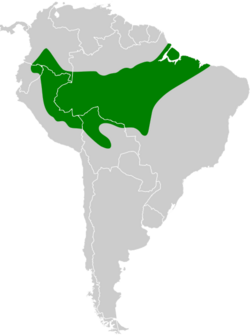Biology:Black-spotted bare-eye
| Black-spotted bare-eye | |
|---|---|

| |
| Scientific classification | |
| Domain: | Eukaryota |
| Kingdom: | Animalia |
| Phylum: | Chordata |
| Class: | Aves |
| Order: | Passeriformes |
| Family: | Thamnophilidae |
| Genus: | Phlegopsis |
| Species: | P. nigromaculata
|
| Binomial name | |
| Phlegopsis nigromaculata (d'Orbigny & Lafresnaye, 1837)
| |

| |
| Synonyms | |
| |
The black-spotted bare-eye (Phlegopsis nigromaculata) is a species of insectivore passerine bird in the antbird family Thamnophilidae. It is found in Bolivia, Brazil , Colombia, Ecuador, and Peru. Its natural habitats are subtropical or tropical moist lowland forests.[1]
The black-spotted bare-eye was described by the French naturalists Alcide d'Orbigny and Frédéric de Lafresnaye in 1837 and given the binomial name Myothera nigro-maculata.[2] The specific epithet combines the Latin words niger for "black" and maculatus for "spotted".[3]
There are four subspecies:[4]
- Phlegopsis nigromaculata nigromaculata (d'Orbigny & Lafresnaye, 1837) – southeast Colombia, east Ecuador, east Peru, north Bolivia and southwest Amazonian Brazil
- Phlegopsis nigromaculata bowmani Ridgway, 1888 – south central Amazonian Brazil and central Bolivia
- Phlegopsis nigromaculata confinis Zimmer, JT, 1932 – east central Amazonian Brazil
- Phlegopsis nigromaculata paraensis Hellmayr, 1904 – northeast Brazil south of the Amazon
The black-spotted bare-eye is 16.5–17.5 cm (6.5–6.9 in) in length and weighs 42–51 g (1.5–1.8 oz). The sexes are alike.[5]
This species is a specialist ant-follower that relies upon swarms of army ants to flush insects and other arthropods out of the leaf litter.[6]
References
- ↑ 1.0 1.1 BirdLife International (2016). "Phlegopsis nigromaculata". IUCN Red List of Threatened Species 2016: e.T22701945A93854954. doi:10.2305/IUCN.UK.2016-3.RLTS.T22701945A93854954.en. https://www.iucnredlist.org/species/22701945/93854954. Retrieved 13 November 2021.
- ↑ d'Orbigny, Alcide; de Lafresnaye, Frédéric (1837). "Synopsis Avium" (in la). Magasin de Zoologie 7 (2): 1–88 [14]. https://biodiversitylibrary.org/page/37087459.
- ↑ Jobling, James A. (2010). The Helm Dictionary of Scientific Bird Names. London: Christopher Helm. p. 272. ISBN 978-1-4081-2501-4. https://archive.org/details/Helm_Dictionary_of_Scientific_Bird_Names_by_James_A._Jobling.
- ↑ Gill, Frank; Donsker, David, eds (2018). "Antbirds". World Bird List Version 8.1. International Ornithologists' Union. http://www.worldbirdnames.org/bow/antbirds/.
- ↑ Zimmer, K.; Isler, M.L. (2018). del Hoyo, J.; Elliott, A.; Sargatal, J. et al.. eds. "Black-spotted Bare-eye (Phlegopsis nigromaculata)". Handbook of the Birds of the World Alive (Lynx Edicions). doi:10.2173/bow.bsbeye1.01. https://www.hbw.com/node/56856. Retrieved 18 February 2018.
- ↑ Zimmer, K.; Isler, M.L. (2018). del Hoyo, J.; Elliott, A.; Sargatal, J. et al.. eds. "Typical Antbirds (Thamnophilidae)". Handbook of the Birds of the World Alive (Lynx Edicions). doi:10.2173/bow.thamno3.01. https://www.hbw.com/node/52291. Retrieved 17 February 2018.
Further reading
- Cadena, C.D.; Londoño, G.A.; Parra, J.L. (2000). "Nesting records of five antbird species from the Colombian Amazon". Wilson Bulletin 112 (3): 313–317. doi:10.1676/0043-5643(2000)112[0313:NROFAS2.0.CO;2]. https://biodiversitylibrary.org/page/53469473.
- Willson, Susan K. (2004). "Obligate army-ant-following birds: a study of ecology, spatial movement patterns, and behavior in Amazonian Peru". Ornithological Monographs (55): 1–67. doi:10.2307/40166802. https://sora.unm.edu/sites/default/files/journals/om/om055.pdf.
Wikidata ☰ Q903893 entry
 |


